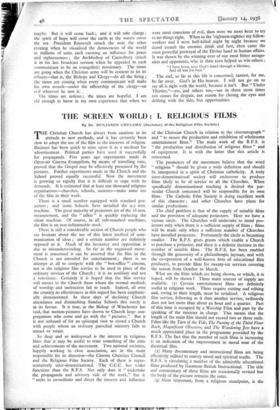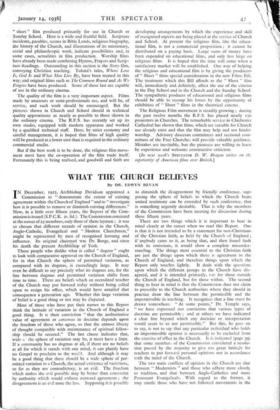THE SCREEN WORLD : I. RELIGIOUS FILMS
By Dr. BENJAMIN GREGORY (Secretary of the Religious Film Society)
THE Christian Church has always been cautious in its attitude to new methods, and it has certainly been slow to adopt the use of the film in the interests of religion. Business has been quick to seize upon it as a medium for advertisement. Political parties have used it successfully for propaganda. Five years ago experiments made in Open-air Cinema Evangelism, by means of travelling vans, proved that the Gospel may be effectively presented by the pictures. Further experiments made in the Church and the School proved equally successful. Now the movement- is growing so rapidly that it is difficult to cope with its demands. It is estimated that at least one thousand religious organisations—churches, schools, societies—make some use of the film in their work.
There is a small number equipped with standard pro- jectors ; and some Schools have installed the 9.5 mm. machine. The great majority of projectors are of the 16 mm. measurement, and the " talkie " is quickly replacing the silent machine. Of course, in all sub-standard machines, the film is on non-inflammable stock.
There is still a considerable section of Church people who are hesitant about the use of this latest method of com- munication of ideas ; and a certain number are definitely opposed to it. Much of the hesitancy and opposition is due to misunderstanding. So far as the organised move- ment is concerned it can be asserted that the film in the Church is not intended for entertainment ; there is no attempt at all to compete with the " box-office " cinema, nor is the religious film service to be used in place of the ordinary services of the Church ; it is an auxiliary and not a substitute. Certainly it is hoped that the film service will attract to the Church those whom the normal methods of worship and instruction fail to reach. Indeed, all over the country its effectiveness in this regard has been emphatic- ally demonstrated. In these days of declining Church attendance and diminishing Sunday Schools this surely is in its favour. It is true, as the Bishop of Winchester has said, that motion-pictures have drawn to Church large con- gregations who come and go with the " pictures." But it is not unheard of for an episcopal visit to crowd a Church with people whom an ordinary parochial ministry fails to attract or retain.
So deep and so widespread is the interest in religious films that it may be useful to state something of the aims and achievements of the movement. Two national societies, happily working in close association, are in the main responsible for its direction—the Cinema Christian Council and the Religious Film Society.. Each of these is repre- sentatively inter-denominational. The C.C.C. has wider functions than the R.F.S. Not only does it " undertake the propaganda and advisory side of the . work," but it " seeks to co-ordinate •and direct the interest and influence of the Christian Church in relation to the cinematograph " and " to secure the production and exhibition of wholesome entertainment films." The main work of the R.F.S. is " the production and distribution of religious films" and of equipment. It is with the latter that this article is concerned.
The promoters of the movement believe that the word " religious " should be given a wide definition and should be interpreted in a spirit of Christian catholicity. A truly inter-denominational society will endeavour to produce films likely to be of service to all the Churches. When specifically denominational teaching is desired the par- ticular Church concerned will be responsible for its own films. The Catholic Film Society is doing excellent work of this character ; and other Churches have plans- for similar productions.
The chief problem is that of the supply of suitable films and the provision of adequate projectors. Here we have a vicious circle. The Churches will undertake to instal pro- jectors only when there is a sufficient supply of films ; films will be made only when a sufficient number of Churches have installed projectors. Fortunately the circle is becoming smaller. The R.F.S. gives grants which enable a Church to purchase a projector, and there is a definite increase in the number of suitable films. The R.F.S. has been enabled through the generosity of a philanthropic layman, and with the• co-operation of a well-known firm of educational film producers, to provide films for twenty-six services covering the season from October to March.
What are the films which are being shown, or which, it is hoped, will be shown ? Three main sources of supply are available. (t) Certain entertainment films are definitely useful in religious work. These require cutting and editing' and, owing to their length, must be serialised. A religious film service, following as it does another service, ordinarily does not last more than about an hour and a quarter. Part of this time is occupied by a Worship Film and part by the speaking of the minister in charge. This means that the length of the main film should not exceed two or three reels. Films like the Turn of the Tide, The Passing of the Third Floor Back, Magnificent Obsession, and The Wandering Jew have a much appreciated place in the programme provided by the R.F.S. The fact that the number of such films is increasing is an indication of the improvement in moral tone of the theatrical film.
(2) Many documentary and instructional films are being effectively utilised to convey moral and spiritual truths The R.F.S. is circulating a number of the admirable educational films produced by Gaumont-British Instructional. The title and commentary of these films are occasionally revised but the body of the picture remains the same.
(3) Most important, from a religious standpoint, is the " short " film produced primarily for use in Church or Sunday School. Here is a wide and fruitful field. Scripture incidents, parables, scenes in Bible Lands, religious biography, the history of the Church, and illustrations of its missionary, social and philanthropic work, indicate possibilities and, in some cases, actualities in film production. Worship films have already been made combining Hymns, Prayers and Scrip- ture Readings. Outstanding in this section is the Story film, conveying Christian teaching: Tolstoi's tales, Where Love Is, God Is and What Men Live By, have been treated in this way, and original films such as The Common Round and As We Forgive have been produced. Some of these last are capable of use in the ordinary cinema.
The quality of the film is a very important aspect. Films made by amateurs or semi-professionals are, and will be, of service, and such work should be encouraged. But the pictures shown in Church and School should in technical quality approximate as nearly as possible to those shown in the ordinary cinema. The R.F.S. has recently set up its own studio, equipped with modern apparatus and worked by a qualified technical staff. Here, by strict economy and careful management, it is hoped that .films of high quality will be produced at a lower cost than is required in the ordinary commercial studio.
But if the best work is to be done, the religious film move- ment must have the co-operation of the film trade itself. Fortunately this is being realised, and goodwill and faith are developing arrangements by which the experience and skill of recognised experts are being placed at the service of Church and School. At present the religious film, like the educa- tional film, is not a commercial proposition ; it cannot be distributed on a paying basis. Large sums of money have been expended on educational films, and only less large on religious films. It is hoped that the time will come when a satisfactory market will be established. One way of helping the religious and educational film is by giving the producers of " Short " films special consideration in the new Films Bill. The treatment which this Bill affords to the " Short " film will, immediately and definitely, affect the use of the cinema in the Day School and in the Church and the Sunday School. The sympathetic producer of educational and religious films should be able to recoup his losses by the opportunity of exhibition of " Short " films in the theatrical cinema.
The Religious Film movement is steadily growing ; during the past twelve months the R.F.S. has placed nearly 15o projectors in Churches. The remarkable service in Chichester Cathedral has shown that films, which are suitable for Church use already exist and that the film may help and not hinder worship. Advisory diocesan committees and sectional com- mittees of the Free Churches will provide valuable guidance. Mistakes are inevitable, but the pioneers are willing to learn by experience and welcome constructive criticism.
[In next week's SPECTATOR D. W. Brogan writes on tin superiority of American films over British.]







































 Previous page
Previous page